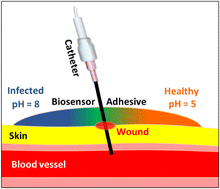Color changing bioadhesive barrier for peripherally inserted central catheters†
Abstract
Bacteria migration at catheter insertion sites presents a serious complication (bacteraemia) with high mortality rates. One strategy to mediate bacteraemia is a physical barrier at the skin-catheter interface. Herein a colorimetric biosensor adhesive (CathoGlu) is designed and evaluated for both colorimetric detection of bacterial infection and application as a bacteria barrier. The design intent combines viscous, hydrophobic bioadhesive with an organic pH indicator (bromothymol blue). Visual observation can then distinguish healthy skin at pH = ∼5 from an infected catheter insertion site at pH = ∼8. The liquid-to-biorubber transition of CathoGlu formulation occurs via a brief exposure to UVA penlight, providing an elastic barrier to the skin flora. Leachates from CathoGlu demonstrate no genotoxic and skin sensitization effect, assessed by OECD-recommended in vitro and in chemico assays. The CathoGlu formulation was found non-inferior against clinically approved 2-octyl-cyanoacrylate (Dermabond™), and adhesive tape (Micropore™) within an in vivo porcine model. CathoGlu skin adhesive provides new opportunities to prevent sepsis in challenging clinical situations.



 Please wait while we load your content...
Please wait while we load your content...